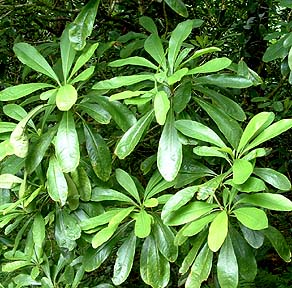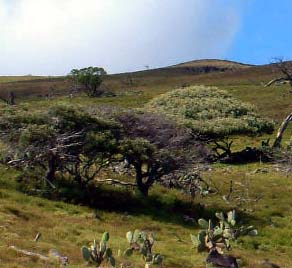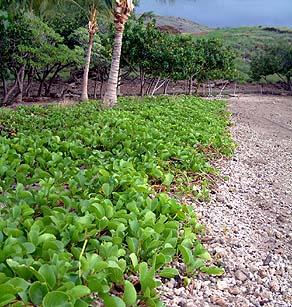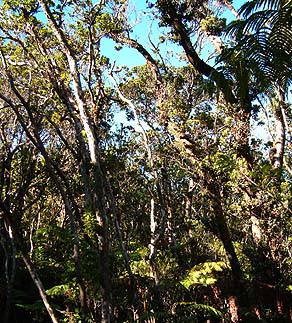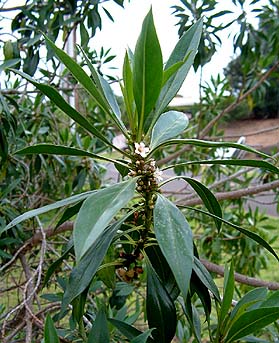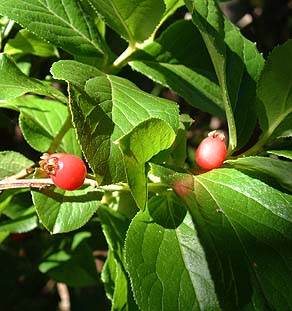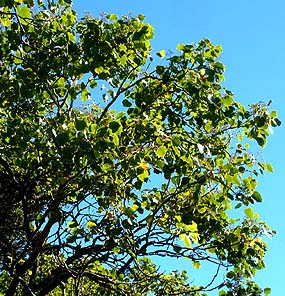 |
 |
 |
|||||
|
|
|||||||
|
|
|||||||
| |
|
|
|
“When you look at the Kohola mountain,” Sam begins, “Pu‘u o Umi, the summit, reaches up to 6,260 feet. That puts it well into the montane zone. Anything above 3,000 feet qualifies as 'montane' in Hawai‘i. An island that’s that high is likely to intercept the clouds. You’ll have a very wet, cool zone above 3,000 feet where clouds form and rain falls. "And in the Kohola mountains, it’s a large zone from 6,000 feet all the way down to 3,000 feet, which is essentially still heavily forested, although some of the sections at about 3,000 feet, especially toward the west side of the mountain range, have been converted to pasture. But in the old days, in pre-human times certainly, there would have been in thick, native, wet forests."
|
||
|
|
||
“All the way down to 1,500 feet or so there would have been closed to open forest of mesic form, meaning it’s not wet and not dry, right in between. That’s where you would hit the maximum in number of tree species. That list would include thirty, thirty-five different species of trees. Things like ho‘awa, and in the gulch there, you would have the dryer form of ‘ohi‘a, kolea. Probably things like maua, definitely naio, and the like. “And below that it would get more open and sparse. You would have a woodland, essentially. Trees, scattered trees above pili grass and native shrubs. That dry forest zone was no doubt really rich. It would have included a lot of lowland dry species such as lama and wiliwili, and probably ‘ohe makai, as well as dry forms of sandalwood and dry forms of other trees such as kolea and the like."
|
|
|
"That would range from there all the way down until you hit about fifty inches of rainfall a year. There’s a whole zone in which it probably would have been koai‘a and ‘iliahi, and other native trees. "That would have extended far down, to the fifty inches per year line. And then when you got down below five hundred feet or so, it would be mostly just grassland and shrubland. Although, wiliwili would grow all the way down to near the coast. "So the vegetation zones would start with the montane wet-forest zone, including bogs, and would move down the flanks into montane mesic zone, and down into a lowland mesic and dry, and finally down into a lowland and coastal very dry zone."
|
|
|
|
"That very-dry zone is going to be able to support only dwarf shrublands and dry grasslands, like pili grasslands. I’m sure pili grassland was a really important part of the Kawaihae coast and lowlands, along with dry shrublands such as ‘ilima shrubland, as well as pukiawe and ‘akia shrubland. "If you drive up the Kawaihae road toward Waimea, you run through a zone in which you can still see, on the road cuts and on the side, remnants of ‘akia and a‘ali‘i, which were probably the dominant shrubs over there. So it was probably a zone in which ko‘oko‘olau, pili, ‘akia, a‘ali‘i, all of those dry shrubs would have been prevalent with occasional wiliwili."
|
||
|
|
||
"Kawaihae Harbor is under ten inches a year. So, it would go from sparse grassland and dwarf shrubland, up into an open woodland of dry trees such as wiliwili and lama and dry-form ‘ohi‘a. And then up into the more mesic forest of koai‘a and other species. The next zone would have been a really rich mix of mesic tree species: kolea and maua, mehame, koai‘a, ‘ohi‘a, and the drier forms of ‘olapa—up to about twenty-five, thirty-five different species of trees as you went up the mountain. "But eventually, the wetter forms of the ‘ohi‘a would become prominent as it went higher and wetter, since in that zone ‘ohi‘a is able to dominate. It would get wetter and wetter until you get into the wet forest tree species such as ‘ohi‘a, ‘olapa, kawa‘u, tree ferns like hapu‘u. And then all of the wet forest shrubs."
|
|
|
"Unfortunately, the richest zone, the zone say between 1,500 and 3,000 feet where that rich mesic forest would have been—and where all of the sandalwood would have been growing—that was almost completely converted into pasture. There are a few enticing remnants of things growing in various gulches there and, in fact, there are some restoration plans to re-establish ‘iliahi in some of the Kawaihae lands. And that’s a good thing." "As soon as Polynesians arrived," Hannah says, "they had certain material needs for shelter and fuel for fire, and so the retreat of the forest began with the arrival of the first of us. At lower elevation, I’m imagining that there was ‘ohi‘a, naio, and mamane. All three species have a wide range from sea level up to tree line, and we could join with those three the lama—the native persimmon—and the wiliwili."
|
"I imagine those to be the tree species that, if not growing immediately at Kawaihae, would have provided hard wood, both for building materials and for fuel." “The forest line used to be way below,” Papa notes. “You see now it’s way up high. What I see now, the forest line is above. But in the past it was way below. In Waimea the forest line is down.” “In the early 19th century, a forest of naio, koai‘e and ‘ohi‘a still existed at Kawaihae Uka,” Langlas writes, “even though cattle were being grazed there. [Kawaihae Uka resident] Helen Aveiro said that, ‘When I grew up had all trees all the way down by our house.’” (Langlas 1994: 19). “The forest goes from maybe around 4,000 to over 6,000 feet.” Sam says. “That’s a very wild place. It’s a very difficult place to explore extensively."
|
|
|
|
|
|
“My Dad and my brother went there for hunting,” ‘Ilima says. "Wild pigs. In fact my brother got lost once. He had to climb the tallest tree to see where he was. You can get lost in no time." “If you’re not familiar with that forest up there,” says Pua’s husband Louie Tavares, “on a nice clear day like this, you go in the morning, and by 2:00 o’clock, get out of there. Because it just closes in on you. We know the forest, so more or less we can tell. But the guys that don’t know, it doesn’t take much. You cannot follow the streams in there. If follow the streams, some of them go back, turn around and go back. "All you have to realize is, the more you move, the more you’re going to get lost. So you cut yourself some ferns, build yourself a little shack, stay in there and wait. Wait until somebody comes, or wait until morning. Don’t’ travel, you’re going to get further away."
|
||
|
|
||
"On a clear day, before I go into the forest, I check which way the wind is blowing. Although in the forest the wind changes directions, but normally it will stay on the same course up there. And look at the sun. Everybody has their own tricks. "By 2:00 o’clock, 2:30, get out of there. If fog is already there when I’m traveling, when I go in I cut the hapu‘u, and turn them over—they’re a different color underneath. So the way you face it, the tip goes to certain place. That’s the direction you’re traveling. So always, you cut one more, do that, cut one more, do that—but not to damage it. Just small kind. So when you come back, you’re going to come back against that."
|
|
|
"Forest protocol in general," Sam explain, "the whole idea is to ask permission first, whether you’re entering or whether you’re taking something, and to state your intent, and to just acknowledge that what you’re taking is not a trivial thing. That it’s something important, and that you recognize that it’s not something that you can just take or get any time. You have to acknowledge its source and respect its source. That’s essentially what the protocols involved would be. "Typically one or more of the forest akua would be named. In a halau hula, you talk about Laka, who is a forest goddess. One of my favorite oli to Laka for forest entrance is the Kau Kahali‘a, that talks about how Laka awakens you in the middle of the night with the song of birds and a vision of ‘ohi‘a trees going up the ridges and that, when you get that vision, you have to go up and be there again."
|
"And the chant that we were taught for collecting is a chant to Lono, Ku and Hina. Lono, because of Lono’s role in healing—not that any of the other gods don’t also have very important roles in healing. And Ku and Hina, because Ku and Hina are the god and consort goddess of forest. "So that chant says essentially ‘here is one of the descendants and I’ve come to pick a particular thing.’ And you say what it is, and you make your plea and you acknowledge that it’s from Ku and from Hina that such things exist. And then you ask permission to take that and to make good use of it."
|
|
| |
|
"The idea is to take only that which you need," Sam concludes, "And you can put back in both material and non-material ways. You can put back by putting your mana into your prayer of asking permission. Essentially, by invoking those gods, you’re feeding them with the mana that it takes for you to give that oli, that pule, to them. So that’s the kind of give-and-take that might be involved there."
|
||
|
|
||
|
|
|
|
|
|

|
| Kawaihae Home | Map Library | Site Map | Hawaiian Islands Home | Pacific Worlds Home |
|
|
|
|
|
|
|||
| Copyright 2006 Pacific Worlds & Associates • Usage Policy • Webmaster |
|||

